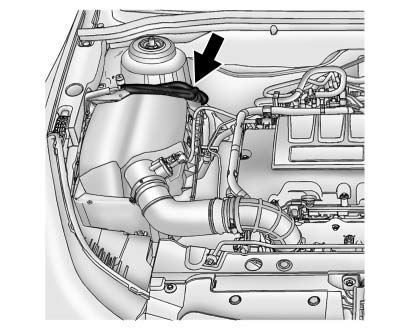Chevrolet Cruze Owners Manual: Engine Heater
The engine heater, if available, can help in cold weather conditions at or below −18°C (0°F) for easier starting and better fuel economy during engine warm-up. Plug in the heater at least four hours before starting the vehicle. An internal thermostat in the plug end of the cord will prevent engine heater operation at temperatures above −18°C (0°F).
To Use The Engine Heater
1. Turn off the engine.

1.4L Engine Shown, 1.8L Similar
2. Open the hood and unwrap the electrical cord. The electrical cord is located on the passenger side of the engine compartment, behind the air cleaner.
3. Plug it into a normal, grounded 110-volt AC outlet.
WARNING
Plugging the cord into an ungrounded outlet could cause an electrical shock. Also, the wrong kind of extension cord could overheat and cause a fire. You could be seriously injured. Plug the cord into a properly grounded three-prong 110-volt AC outlet.
If the cord will not reach, use a heavy-duty three-prong extension cord rated for at least 15 amps
.
4. Before starting the engine, be sure to unplug and store the cord as it was before to keep it away from moving engine parts.
If you do not it could be damaged.
The length of time the heater should remain plugged in depends on several factors. Ask a dealer in the area where you will be parking the vehicle for the best advice on this.
 Starting the Engine
Starting the Engine
Place the transmission in the proper gear.
Notice: If you add electrical parts or accessories, you could change
the way the engine operates. Any resulting damage would not be covered by the vehicle ...
 Retained Accessory Power (RAP)
Retained Accessory Power (RAP)
These vehicle accessories may be used for up to 10 minutes after the engine is
turned off:
• Audio System
• Power Windows
• Sunroof
The power windows and sunroof will continue to work for up to ...
Other materials:
Engine Compartment Overview
1.4L L4 Engine
1. Engine Air Cleaner/Filter
2. Engine Oil Dipstick.
3. Engine Cooling Fan (Out of View).
4. Engine Oil Fill Cap.
5. Remote Negative (-) Grounding Point.
6. Brake/Clutch Fluid Reservoir.
7. Battery
8. Engine Coolant Surge Tank and Pressure Cap.
9. Remote Positive (+ ...
Drunk Driving
Death and injury associated with drinking and driving is a global tragedy.
WARNING
Drinking and then driving is very dangerous. Your reflexes, perceptions, attentiveness,
and judgment can be affected by even a small amount of alcohol. You can have a serious
— or even fatal — collision if you d ...
Accident With or Without Air Bag Deployment - Component Inspections
Warning: Proper operation of the Supplemental Inflatable Restraint
(SIR) sensing system requires that any repairs to the vehicle
structure return the vehicle structure to the original production configuration.
Not properly repairing the vehicle structure could cause
non-deployment of the air b ...
